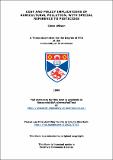Files in this item
Cost and policy implications of agricultural pollution, with special reference to pesticides
Item metadata
| dc.contributor.advisor | FitzRoy, Felix | |
| dc.contributor.author | Wilson, Clevo | |
| dc.coverage.spatial | 270 | en_US |
| dc.date.accessioned | 2013-06-19T10:45:28Z | |
| dc.date.available | 2013-06-19T10:45:28Z | |
| dc.date.issued | 1999 | |
| dc.identifier | uk.bl.ethos.558521 | |
| dc.identifier.uri | https://hdl.handle.net/10023/3725 | |
| dc.description.abstract | Modem commercial agricultural practices involving chemical inputs such as fertilisers and pesticides have been associated with huge increases in food production never witnessed before, and in the case of cereal production (especially wheat) under Green Revolution technology, recorded spectacular growth. As statistics show, production and productivity have increased. However, the high chemical usage of fertilizers and pesticides used to bring about these increases in food production are not without problems. A visible parallel correlation between higher productivity, high artificial input use and environmental degradation and human health effects is evident in many countries where commercial agriculture is widespread. The high usage of these chemical inputs has caused numerous pollution problems impacting on human health, agricultural land, other production processes, wildlife and the environment in general. The private and external costs are very high. Such a production path is clearly unsustainable. This Ph.D. study lays its focus on estimating the private costs of illnesses arising from direct exposure to pesticides during handling and spraying by farmers on their farms in Sri Lanka. For this purpose three valuation techniques are used. They are the contingent valuation, cost of illness and the aversive behaviour approaches. Multiple regression analyses are also carried out to establish several relationships involving pesticide handling/spraying and direct exposure to pesticides. Policy implications of the regression analyses are then discussed. A health production model showing the relationships between the three approaches used for estimating the private costs of ill health and thereby inferring the willingness to pay for pollution control is presented. The theoretical background to agricultural pollution, drawing examples mostly from Asia, is also dealt within this thesis. Data for this Ph.D. study were obtained from a field survey carried out in the summer of 1996. During this survey, 227 subsistence farmers handling and spraying pesticides on a regular basis were interviewed to gather the necessary data. For the analysis of data, only 203 samples are used. | en_US |
| dc.language.iso | en | en_US |
| dc.publisher | University of St Andrews | |
| dc.rights | Creative Commons Attribution-NonCommercial-NoDerivs 3.0 Unported | |
| dc.rights.uri | http://creativecommons.org/licenses/by-nc-nd/3.0/ | |
| dc.title | Cost and policy implications of agricultural pollution, with special reference to pesticides | en_US |
| dc.type | Thesis | en_US |
| dc.contributor.sponsor | Russell Trust | en_US |
| dc.type.qualificationlevel | Doctoral | en_US |
| dc.type.qualificationname | PhD Doctor of Philosophy | en_US |
| dc.publisher.institution | The University of St Andrews | en_US |
This item appears in the following Collection(s)
Except where otherwise noted within the work, this item's licence for re-use is described as Creative Commons Attribution-NonCommercial-NoDerivs 3.0 Unported
Items in the St Andrews Research Repository are protected by copyright, with all rights reserved, unless otherwise indicated.


